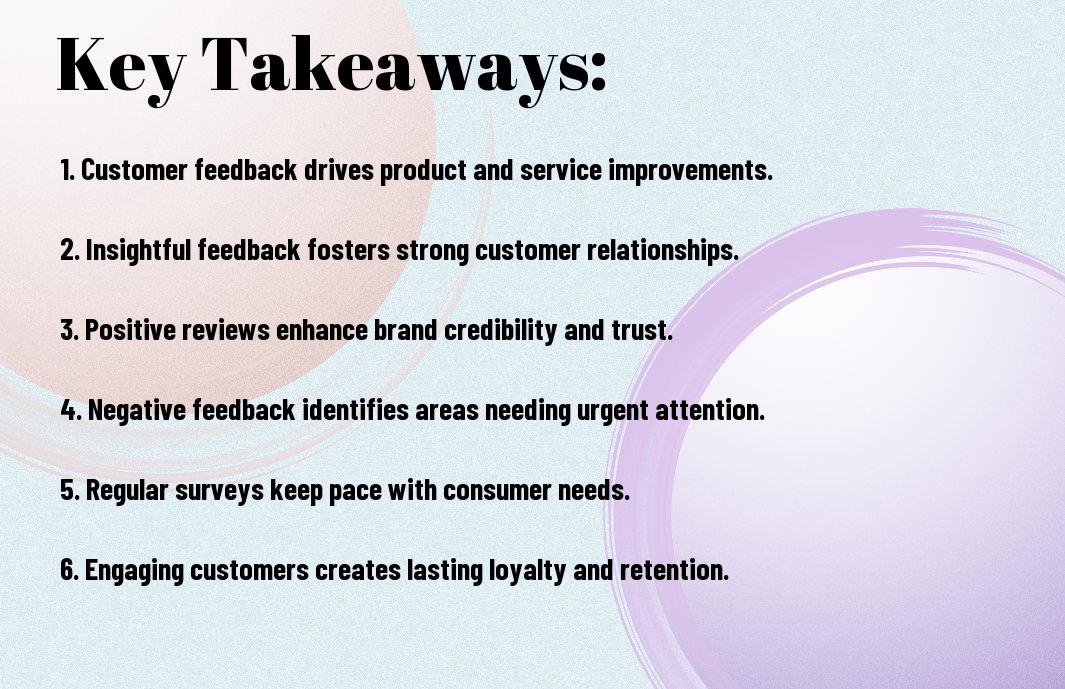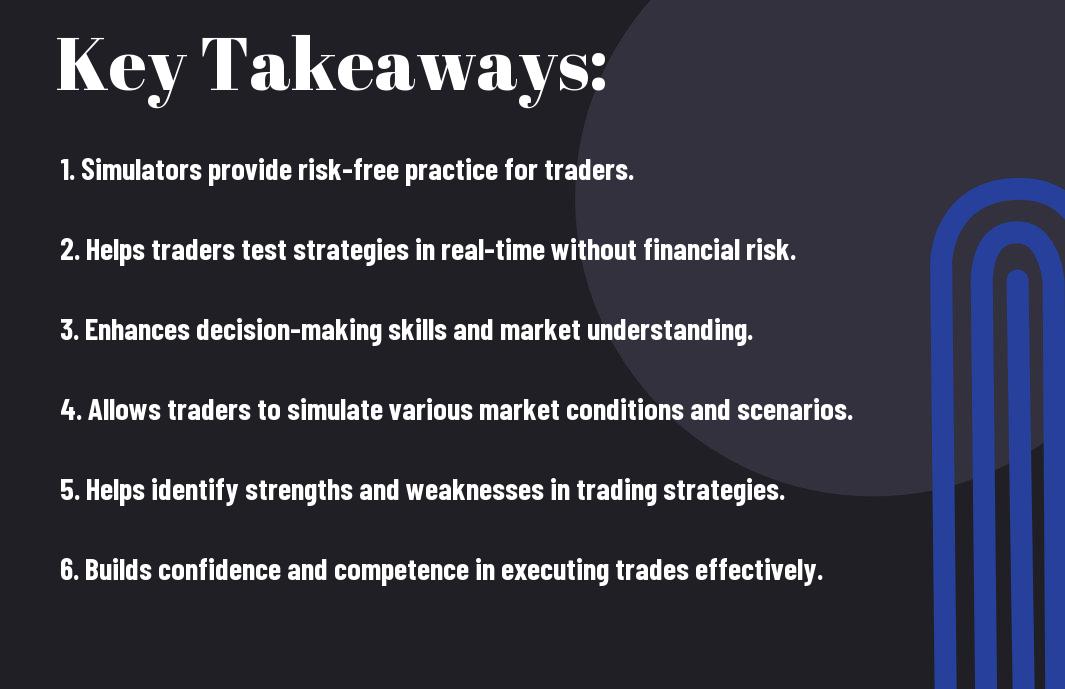Just as your business evolves, so do the needs and preferences of your customers. Understanding the role of customer feedback is imperative for enhancing your products and services, guiding your business decisions, and fostering stronger relationships with your clientele. By actively listening to your customers, you gain valuable insights that can shape your strategies and drive growth. In this blog post, we will explore how effectively harnessing customer feedback can propel your business development efforts to new heights.
Key Takeaways:
- Insights for Improvement: Customer feedback provides valuable insights that help businesses identify strengths and areas for improvement in their products or services.
- Customer Engagement: Actively seeking and responding to feedback fosters a sense of engagement and loyalty among customers, making them feel valued and heard.
- Informed Decision-Making: Utilizing customer feedback in business strategies enables informed decision-making, allowing companies to align their offerings with market demands and customer expectations.

Understanding Customer Feedback
The purpose of customer feedback is to gain insights into your products, services, and overall customer experience. This information can guide you in making informed decisions to improve your business practices and build stronger connections with your customers.
Types of Customer Feedback
- Surveys
- Online reviews
- Social media comments
- Focus groups
- Direct customer interactions
This variety of feedback channels allows you to gather a comprehensive understanding of your customers’ sentiments and needs.
| Type of Feedback | Purpose |
| Surveys | Measure satisfaction levels |
| Online Reviews | Assess product performance |
| Social Media Comments | Gauge public perception |
| Focus Groups | Understand customer motivations |
Importance of Collecting Feedback
Customer feedback is vital for your business, as it provides actionable insights and helps you identify areas for improvement. Listening to your customers allows you to tailor your offerings to better meet their expectations.
Considering the fast-paced nature of today’s market, collecting feedback enables you to stay ahead of the competition and adjust your strategies accordingly. By fostering an environment where customers feel heard, you enhance their loyalty and build a community around your brand. Ultimately, this practice not only supports long-term success but also establishes a foundation for continuous development and innovation tailored to your customers’ needs.
Analyzing Customer Feedback
While gathering feedback is important, analyzing it effectively is even more critical for making informed business decisions. You need to sift through the qualitative and quantitative data to identify patterns, trends, and areas for improvement. This process involves categorizing the feedback based on different criteria such as customer sentiment, product features, or service aspects, helping you focus on what truly matters to your customers.
Tools and Techniques
About utilizing various tools and techniques can streamline your analysis of customer feedback. Survey platforms, social media analytics, and customer relationship management (CRM) systems are invaluable resources. These tools help you aggregate data and gain insights into customer preferences and pain points, allowing you to make data-driven decisions that align with customer needs.
Interpreting Data Effectively
Data interpretation plays a significant role in extracting meaningful insights from the feedback you receive. You should evaluate both quantitative metrics, like satisfaction scores, and qualitative comments to develop a well-rounded understanding of your customers’ experiences.
But interpreting data effectively goes beyond simply looking at numbers or comments. It requires contextualizing the information within your business goals and market conditions. By combining quantitative findings with qualitative insights, you can create a comprehensive picture of customer sentiment, allowing you to make better decisions and adjustments that align your business with customer expectations.
Implementing Changes Based on Feedback
Keep in mind that the effectiveness of your business development hinges on how well you implement feedback. It’s imperative to analyze the insights gathered from your customers and translate them into actionable steps. This process not only shows that you value customer input but also enhances your products and services, making them more aligned with market demand and customer expectations.
Developing Actionable Strategies
To turn feedback into meaningful changes, you should focus on developing actionable strategies. Begin by categorizing the feedback to identify common themes, then outline specific changes that address these insights. By prioritizing these strategies, you can create a targeted plan that allows for efficient implementation and measurable outcomes.
Communicating Changes to Customers
By effectively communicating changes to your customers, you not only build trust but also engage them in your business journey. Transparency about the adjustments made based on their feedback shows that you listen and care about their opinions.
This communication should be clear and concise, emphasizing how the changes directly benefit your customers. Use multiple channels such as emails, newsletters, or social media to reach a wider audience. Additionally, consider inviting feedback on the changes to keep the conversation open and foster a continuous improvement mindset. This engagement not only increases customer loyalty but also positions your business as responsive and customer-centric.
Measuring the Impact of Feedback
After gathering customer feedback, it’s necessary to measure its impact on your business strategies. By analyzing feedback effectively, you can identify areas where you excel and those needing improvement. Tracking this data will help you make informed decisions that align with your customers’ desires. For further insights, explore this article on The Role of Customer Feedback in Business Growth.
Key Performance Indicators
The effectiveness of customer feedback can be evaluated through Key Performance Indicators (KPIs). These metrics, such as customer satisfaction scores and retention rates, provide valuable insights into how feedback translates into actionable improvements. By regularly reviewing these KPIs, you can ensure that customer feedback is playing a significant role in your business development efforts.
Continuous Improvement Processes
Indicators of success can also be found in your continuous improvement processes. By implementing a feedback loop, you invite customers to share their thoughts regularly, which helps refine your products and services. This ongoing relationship drives innovation and enhances customer loyalty, leading to a more sustainable growth trajectory.
Performance evaluation in continuous improvement is a dynamic process. It involves revisiting your goals, assessing the outcomes of changes made based on feedback, and making adjustments as necessary. By fostering an environment of open communication and adaptation, you can stay aligned with your customers’ evolving expectations, ultimately driving long-term enhancements in your business development strategy.

Case Studies: Success Stories
Not all feedback is created equal, but the following companies have successfully utilized customer insights to propel their growth:
- Airbnb: Increased user satisfaction by 20% after implementing a comprehensive feedback loop.
- Starbucks: Improved customer retention by 10% with a loyalty program based on consumer preferences.
- Amazon: Enhanced product offerings by 25% through regularly analyzed customer reviews and suggestions.
- Microsoft: Increased adoption rates of new features by 30% after soliciting user input during beta testing phases.
Companies That Thrived on Feedback
After adopting a feedback-centric approach, numerous companies have seen significant transformations. For instance, Adobe launched a new feature after receiving user suggestions, which resulted in a 35% increase in overall engagement. Meanwhile, Dell’s dedicated customer feedback initiative allowed them to innovate hardware that led to a 15% rise in sales.
Lessons Learned
With the implementation of customer feedback strategies, you can glean invaluable insights that foster business growth. Many leading companies have developed methods to prioritize feedback, creating stronger relationships with their customers and ensuring a continuously improving product or service.
It is vital to approach customer feedback as an ongoing conversation. Engaging with your customers not only helps identify areas for improvement but also builds brand loyalty and trust. By analyzing feedback, you can effectively make data-driven decisions that align with consumer needs, fostering a culture of responsiveness that can set your business apart in the marketplace.
Challenges in Utilizing Customer Feedback
For any business, harnessing customer feedback can present significant obstacles. Effective collection and analysis processes are necessary to turn insights into action. In exploring The Role of Customer Feedback in Product Development, you’ll discover that simply gathering feedback is not enough; you must be prepared to address the hurdles that come with it.
Common Barriers
Challenges in utilizing customer feedback often stem from misunderstandings, a lack of resources, or ineffective data analysis methods. You might find that your team struggles to interpret customer comments or fails to prioritize feedback among various initiatives. Additionally, organizational silos can prevent the sharing of insights across departments, further complicating the process.
Strategies to Overcome Challenges
After identifying the barriers to effective customer feedback utilization, consider implementing structured strategies to enhance your approach. Fostering an open feedback culture encourages collaboration and transparency across your organization, ensuring that valuable insights do not go unnoticed.
With the right strategies in place, you can effectively transform obstacles into opportunities. Start by prioritizing clear communication channels that facilitate feedback from all departments. Engage your team with training sessions on data analysis, empowering them to extract actionable insights from customer input. Regularly review and prioritize feedback to ensure it is incorporated into your business development process, turning customer suggestions into tangible improvements.
Final Words
Taking this into account, integrating customer feedback into your business development process is important for understanding your audience and refining your offerings. By actively seeking and analyzing feedback, you can identify areas for improvement, enhance customer satisfaction, and foster loyalty. This not only helps you meet customer needs but also positions your business for sustainable growth in an ever-evolving market. Embracing feedback effectively empowers you to make informed decisions that drive positive change and elevate your overall business strategy.
FAQ
Q: Why is customer feedback important for business development?
A: Customer feedback serves as a direct line to understanding how clients perceive your product or service. It helps identify areas of improvement, guides product development, and can highlight market trends that businesses may want to capitalize on. Engaging with customers’ thoughts also fosters loyalty, as consumers appreciate when their opinions are valued. In essence, collecting and analyzing this feedback is vital for informed decision-making that drives growth.
Q: How can businesses effectively collect customer feedback?
A: Businesses can gather customer feedback through various methods, including surveys, interviews, focus groups, and feedback forms on websites. Utilizing social media channels can also be beneficial, as they allow for real-time interaction with customers. Additionally, implementing tools like Net Promoter Score (NPS) can measure customer satisfaction and loyalty. The key is to make the feedback process easy and accessible to encourage participation from a broad audience.
Q: How can companies use customer feedback to enhance their product or service offerings?
A: Companies can analyze customer feedback to identify common themes and issues that need to be addressed. By categorizing feedback into specific areas such as features, usability, and customer service, businesses can prioritize improvements and innovations. Further, this insight can lead to new product development or modifications that align more closely with consumer demands. Regularly incorporating this feedback also helps build a customer-centric approach that can enhance the overall user experience and satisfaction.




